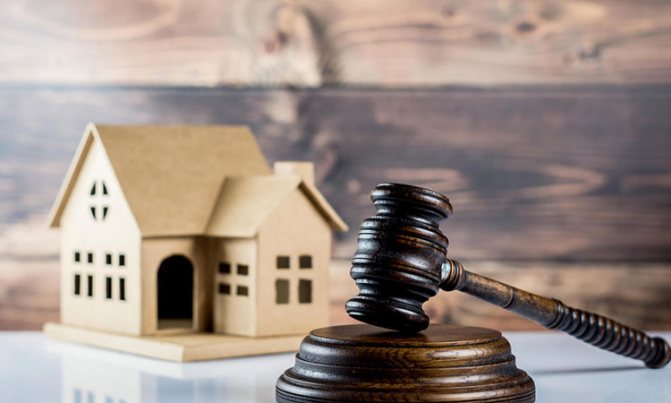A mortgage is the most difficult loan due to the size of the debt and the duration of the contract. While the borrower is repaying the loan, external circumstances may change more than once. Changes in real estate prices, exchange rate fluctuations, and falling wages lead to the fact that the credit burden becomes unbearable. Bankruptcy of individuals with a mortgage Often, in order to maintain a mortgage, when their income decreases, people stop paying other loans. This is due to the fact that a significant initial payment has been made, maternity capital funds have been used, monthly payments have been made for a certain time and the debt amount has been largely repaid. When debts accumulate, you may be tempted to declare bankruptcy but keep your apartment.
Would you like to write off all your debts?
A free consultation with our specialists will allow you to compare risks and take the first steps towards bankruptcy.
Send a request
Unfortunately, such a scenario is not feasible. In bankruptcy, all existing obligations are taken into account and paid off. As part of debt restructuring or the sale of bankruptcy estate, preference cannot be given to one or another creditor. The payment procedure is established by law. All decisions from the moment the process begins will be made for you by the arbitration manager.
Expert opinion
Dmitry Tomilin
Experience more than 8 years.
Free consultation
From the moment the insolvency procedure is introduced for all loans, the full repayment period is considered to have arrived. That is, you must pay off the mortgage in full at this moment.
The bank that issued the mortgage will not want to be excluded from the procedure and will claim its rights to your apartment without waiting for payments according to the established schedule. It will be sold, and the proceeds will be used to pay off all your debts, not just your mortgage.
What do you need to know about declaring bankruptcy with a mortgage?
When planning bankruptcy, you must remember that the apartment purchased with a mortgage does not belong to you. Until the loan is fully repaid, it is pledged to the bank, and your ownership rights are limited. In case of bankruptcy, this automatically excludes the rule of law that protects the debtor’s only home. The apartment becomes ordinary collateral and is subject to sale.
Arbitration manager Bankruptcy of individual entrepreneurs Bankruptcy of individuals
In the legal practice of financial managers, there have been cases when the bankruptcy procedure for a mortgage took place without selling the apartment. This is an accident that cannot be counted on. In order for the apartment to not be sold under a mortgage, it is necessary that the mortgage bank does not submit its claims to the court registry within two months. In this case, the status of the secured creditor will be lost. The mortgaged apartment will not be counted as mortgaged property, but as the only housing.
Banks strictly monitor the observance of their interests and it makes no sense to rely on the negligence of employees.
General features of bankruptcy
Since 2020, an individual can formally submit an application to the court in order to be declared bankrupt. Decisions are made to assign bankrupt status at the legislative level, so it is impossible to independently recognize oneself as such. The concept became in demand due to a significant increase in credit debt and a high proportion of problem loans (mortgages).
Recommended video for viewing:
How to declare yourself bankrupt? In this case, the correctness of actions plays a role, on which the success of the final result depends.
The law provides for specific achievement of bankruptcy status, including in the presence of credit debt (mortgage or other large loan) to the bank. When declaring bankruptcy, you cannot choose individual actions to go to court.
Scheme for bankruptcy of individuals.
There are no special rules for accepting bankruptcy status, so if you have several loans, you can declare yourself insolvent on one of them (for example, a mortgage on an apartment).
In the current economic instability, the inability to pay the monthly mortgage debt is becoming a typical case. Taking out a new loan is not the best decision for the borrower, since such a step will only worsen the situation. An alternative option is to formally declare yourself bankrupt or arrange a mortgage restructuring with a bank.
Bankruptcy procedure for an individual with a mortgage
Before starting the insolvency procedure, you need to carefully prepare, if possible with the help of an experienced lawyer. Then bankruptcy and maintaining the mortgage is possible. To do this, you need to stop at the first stage - debt restructuring and timely repay all payments according to the new schedule established by the arbitration manager.
Would you like to write off all your debts?
Saving your mortgaged apartment is only possible if you manage to achieve restructuring on favorable terms for you. If the sale of property at auction is allowed, the mortgaged apartment will necessarily be sold first. According to the bankruptcy procedure, 80% of the proceeds from its sale will go to the account of the secured creditor - the bank where you took out the mortgage.
To avoid the worst-case scenario, you need to follow the following bankruptcy procedure:
- find in advance a financial manager who is a member of the SRO and is ready to take on your business;
- prepare documents and file a bankruptcy application in court;
- from the moment the application is submitted, the current claims of creditors are suspended, you have the opportunity to try to reach an amicable agreement;
- wait for the first meeting where the FU will be appointed; present a plan (or preferably 2-3 plans) for restructuring and paying off debts;
- If your plan is approved, pay according to the established terms.
Useful articles

Restructuring of individual loans

Are loan debts growing? How to stop interest accrual?

Cost of personal bankruptcy
Standard procedure you should avoid:
- if you cannot cope with payments, the financial institution initiates the procedure for the sale of the bankruptcy estate;
- there will be a search, assessment and inventory of your property;
- tenders will be scheduled and held;
- from the proceeds, payments to financial institutions and loan obligations will be repaid in order in accordance with the law;
- the remaining amount (if any) will be transferred to your account or to the account of a co-borrower;
- the court declares you bankrupt and your loans repaid.
In the second case, it will not be possible to save not only the apartment, but also the funds you paid, including the maternity capital involved.
How does the procedure for declaring the insolvency of foreign currency borrowers take place?
Expert opinion
Evgeniy Belyaev
Legal consultant, financial expert
Ask
A citizen will be assigned bankrupt status by the Arbitration Court, which will open a bankruptcy case based on a received application from the borrower, creditor or a valid court decision.
In order for the procedure to declare a person insolvent to begin, two circumstances must exist:
- The borrower's debt exceeded 500 thousand rubles;
- The loan was overdue for more than 3 months.
Obviously, the amount of 500 thousand rubles for a foreign currency mortgage is more than feasible .
Therefore, foreign currency mortgage holders often become involved in bankruptcy arbitration cases. Bankruptcy of foreign currency mortgage holders is considered a beneficial solution to the problem because debts for which there are insufficient funds to repay are automatically recognized as repaid.
The disputed object in bankruptcy is an apartment pledged to the bank . Even if it is the borrower’s only home, it can be sold by the bank at auction. The proceeds from its sale will be used to pay off the debt.
This is, of course, an extreme measure that the bank has every right to take. But more often than not, the dispute ends in more amicable settlements aimed at revising the mortgage agreement and creating acceptable conditions for repaying the obligation.
When bankruptcy proceedings are opened, the court appoints an arbitration manager, to whom all financial affairs of the potential bankrupt are transferred . The manager gets access to bank accounts, income and cards. Its main task is to organize the most effective dialogue between creditors and the debtor.
He needs to avoid the sale of property by all means and facilitate the settlement of the dispute. For this, he receives a good reward, which, by law, will have to be paid to the borrower who is already in a difficult financial situation.
Mortgage restructuring
With the help of restructuring, it becomes possible to approve a new debt repayment schedule, terms and procedure for paying a mortgage loan.
The most important thing is that the debt, on the basis of current legislation, will be converted into rubles and recorded by the court. After the Arbitration Court accepts the application to declare the debtor bankrupt, interest on the mortgage loan ceases to accrue.
In addition, all kinds of fines and penalties for late payments will also not apply to the borrower. The court will fix a new procedure for repaying the mortgage; exchange rate fluctuations will no longer threaten the borrower. This is usually a debt repayment plan that is approved at a meeting of creditors.
Settlement agreement
The settlement agreement applies if the bank does not agree to restructure the mortgage debt.
Expert opinion
Evgeniy Belyaev
Legal consultant, financial expert
Ask
As a rule, debt restructuring is applied to those bank clients who maintain a constant income and are quite capable of gradually paying off their financial obligations. In a settlement agreement, both parties can agree on any terms for resolving the conflict that suit each of them. This may include a deferred payment.
If the settlement agreement is violated by the borrower, it will cease to have legal force, and litigation will resume again.
Can they take over an apartment with a mortgage in case of bankruptcy?

According to the law, bankruptcy of individuals with a mortgage does not protect the apartment from sale, even if it is the only home of the family. In this case, the process of declaring insolvency should be considered only as a way to suspend payments and the opportunity to achieve installment plans.
Expert opinion
Dmitry Tomilin
Experience more than 8 years.
Free consultation
You must notify the banks in advance that you intend to declare yourself bankrupt. In such a situation, they are more willing to restructure the debt.
If the bankruptcy process has started and the court requires the sale of property, then you need to know:
- the mortgaged apartment will be included in the register, and the secured creditor will be the first to receive payments from the proceeds at the auction;
- the remainder of the amount will be used to pay remuneration to the arbitration manager, pay off legal costs and other debts;
- the cost of housing is determined during an independent examination, it is paid by the debtor, and only if there are no funds, the creditor will pay.
Only that part of the amount that remains after repayment of all obligations will be transferred to the debtor. If the mortgage term was coming to an end, then there is a possibility that the amount would be significant. If less than half the term has passed, then most likely everything will go into debt. From the experience of completed cases, it becomes clear that the amount remaining after all the procedures will not be enough for the debtor to purchase a new apartment.
Consequences of insolvency for lending
Theoretically, after receiving bankruptcy status, you can apply to banks for a new loan even the next day. The only condition is to report financial insolvency to a prospective creditor within five years from the date of completion of the procedure (Clause 1, Article 213.30 of Law No. 127-FZ). No regulation prohibits the receipt of borrowed funds, but banks, microfinance organizations and other lenders are unlikely to agree to this, since they are commercial organizations and not charitable institutions.
The prospect of losing collateral prevents individuals from independently initiating financial insolvency. However, reaching the half-million mark of obligations transforms the voluntary initiative into the obligation of citizens to apply to arbitration (Clause 1 of Article 213.4 of Law No. 127-FZ). Otherwise, interested bankruptcy creditors and government agencies may go bankrupt.
When initiating the process of bankruptcy of individuals with a mortgage on their own, a citizen must be prepared to part with the collateral property assets. The absence of delays for this type of lending in the presence of debts on other loans and credits does not exempt from the loss of mortgage housing, since there are no half bankrupts.
What if there is a mortgage on an apartment if one of the spouses is bankrupt?
Bankruptcy with a mortgage raises especially many questions if you have a family. In a situation where the housing is registered in the name of the second spouse, the collateral property belonging to the bankrupt spouse is not considered as a bankruptcy estate in the process. If you continue making mortgage payments, the mortgaged apartment will not be sold.
Would you like to write off all your debts?
A free consultation with our specialists will allow you to compare risks and take the first steps towards bankruptcy.
Send a request
However, if the second spouse acts as a co-borrower, then a joint ownership regime arises. This means that if a husband or wife goes bankrupt, the shared apartment will be sold, even if minor children are registered in it. In this case, banks often refer to joint and several liability. And it allows, in the event of a delay, to foreclose on the debt of one spouse against the property of the second.
If mortgage payments from the second co-borrower are received regularly, the sale of the apartment can be avoided.
Features of bankruptcy with military and foreign currency mortgages
Mortgage for military personnel is one of the types of government benefits. It is distinguished by a lower annual interest rate, and in addition, enhanced guarantees. The state takes over the payments. This rule applies to those who continue to serve in the military.
If the person who took out a military mortgage leaves service, then the situation changes. He must not only continue to repay the loan, but also return what was paid earlier. The credit burden increases sharply, the debtor may file for bankruptcy. In this case, the procedure will be standard. It is necessary to submit an application to the court, collect and submit a package of documents. The court will appoint an arbitration manager and will first introduce a debt restructuring procedure; based on its results, it is possible either to repay the debts or proceed to the sale of property.
There are some differences between foreign currency mortgages and bankruptcy. People often find themselves unable to pay as a result of changes in the exchange rate of the dollar or euro. At the same time, the debt in national currency may increase so much that it exceeds the real cost of the apartment. At the same time, housing was purchased from many debtors using maternity capital. Here you need the help of an experienced lawyer who will help you introduce the restructuring procedure in the most gentle way for the debtor.
Bankruptcy of foreign currency mortgage holders // Is it salvation?
1. One of the hot topics of recent days is the riots of foreign currency mortgagers. An example is in the video from 32 minutes. There are different opinions about who is to blame for the current situation. However, a much more pressing question is what to do.
A number of experts - Igor Vyshegorodtsev, Mikhail Vasilega, Oleg Zaitsev - on Facebook expressed the idea of the applicability of the debt restructuring procedure in this case.
2. However, based on communication directly with debtors, I see a completely different picture. Typical situation: an apartment costs 6-7 million rubles, in fact the debt at the current exchange rate is 10-11 million rubles. According to the schedule, the debt should be repaid within 5-10 years, but in fact the schedule has already been completely disrupted. There are two options left - negotiations and litigation. The bank is not interested in negotiations, as a result of which all negotiation options - approval and extension by creditors of the restructuring plan, variability in its terms - actually do not work.
Clause 4 art. 213.17 of the Bankruptcy Law provides literally the following: “If the meeting of creditors does not approve a plan for restructuring a citizen’s debts, the arbitration court has the right to approve this plan, provided that its implementation makes it possible to fully satisfy the claims of bankruptcy creditors for obligations secured by a pledge of the citizen’s property.” Careful reading of paragraph 2 of Art. 213.14 of the Bankruptcy Law dictates that the period for implementing the plan in such cases will be only two years.
Attention, question: if a person cannot repay the debt on schedule within 5-10 years, how is it possible to fulfill the five-year plan in two years? Obviously, only a very limited number of debtors can take advantage of this option. Everything else is voluntary; the bank is not formally obliged to make concessions.
UPD I was corrected with reference to paragraph 34 of the Resolution of the Plenum of the RF Armed Forces “On Bankruptcy of Citizens” - they say that during the restructuring it is enough to get out of the situation of arrears, and it is not necessary to repay all debts: “... the goal of restoring the debtor’s solvency will be considered achieved if at the end within the period of its implementation, the debtor will have no overdue obligations and will be able to continue to fulfill his obligations..."
But something tells me that in the harsh Russian reality, this scenario is not very realistic: not only will it be necessary to pay in addition everything unpaid (even taking into account the priority of repaying the principal debt), but in another 2-3 years the debtor needs to be ready to repay debt strictly according to schedule.
Those. Most likely, the debtor can only get some respite, but in the end everything will return to normal - with the exception of rare cases when the debtor receives an inheritance or can sharply, at least double, increase the level of income. A complete solution to the problem has not been and is not expected.
In addition, no one has canceled the bank’s right to demand early repayment of a loan in case of significant delays, which returns the course of events to the idea I originally expressed.
3. The second problem: the cost of the procedure. And this is a double-edged sword. On the one hand, debtors are limited in funds, on the other, bankruptcy managers do not have a burning desire to turn into financial slaves. Thus, the AU’s remuneration is set at 10 thousand rubles. for the procedure, and it will be paid only upon completion of the case.
With a three-year restructuring period, the remuneration actually amounts to 277.77 rubles. per month (9.26 rubles per day). For two years - 416.67 rubles. per month (RUB 13.88 per day). For comparison: in the implementation procedure, which is introduced for a period of 6 months, in the best case, the AU’s remuneration will be 1,666.67 rubles. per month (55.55 rubles per day) - and only if there is no extension.
Administrative risks under Part 3 of Art. 14.13 of the Code of Administrative Offenses of the Russian Federation for any minor error (example - case No. A63-12062/2015) are respectively: from 9000% to 18000%, from 6000 to 12000%, from 1500 to 3000% of the monthly remuneration, i.e. the size of the fine is 15-180 times higher than the monthly remuneration (and we haven’t deducted personal income tax yet!).
And for a repeated violation - absolutely regardless of its severity - the arbitration manager is deprived of the right to the profession for at least six months, and for a maximum of three years.
Under such conditions, the procedure can be undertaken either by an AU - a novice, or frankly “ugly and frail”, or a “suicide bomber”. It’s not surprising that there was talk of a boycott.
Science fiction in the category of “individuals need to be bankrupted wholesale” can only be promoted by people who are infinitely far from practice. For absent debtors, it is enough to send out requests, receive answers, analyze, make reports, and submit them to court. Problems always arise with individuals - I can say from two years of experience working in the Human Rights Commission / V.V.P. Public Reception. / in the district court as an assistant judge. There will always be a dissatisfied person who will write complaints to all authorities simply out of spite - there are enough of them in bankruptcy procedures for legal entities, and among individuals there are even more such persons. As a result, the likelihood of making technical errors grows exponentially, which entails the stated risks.
The conveyor belt of business conduct leads to professional degradation and a drop in quality - this is clearly visible in the example of the legal profession. In this case, the appointed lawyer receives at least 550 rubles. per day - more than AU per month, while it is enough to imitate vigorous activity (or just read a newspaper) and sign where the investigator says - there are no risks of penalties. And if the legal profession is 70-75% of the professional bottom, then where are they pushing the AU?
And I’m not even talking about annual insurance costing from 104 thousand rubles. up to 1.2 million rubles and new contributions to the compensation fund of thousands, 500 each...
That. The restructuring procedure is completely unsuited to the needs of foreign currency mortgagers. The only thing that may be interesting here is the sale of property and “cutting off the mortgage tail,” but the problem of financing one way or another remains relevant.
4. If the legislator really wanted to solve the problems of foreign currency mortgagers, then this could be done without any bankruptcy, obliging banks to carry out out-of-court restructuring under certain conditions. But so far only attempts are being made to solve social problems not at the expense of the state and/or banks, but at the expense of private individuals - arbitration managers. Although in private conversations bank employees openly say: a foreign currency mortgage is a “golden mine” for them, all costs have long been recouped, now everything goes to net profit.
To everyone who believes that everything is as it should be, that arbitration managers are raking in money with shovels: welcome to the profession! Pass exams, pay contributions to the computer fund, insurance, and then drown the uranium scrap in mercury yourself.
How to save a mortgage during bankruptcy?
An experienced lawyer can offer the borrower to buy their own home at auction for a lower cost. Then it is possible to declare bankruptcy, write off existing debts and preserve the debtor’s home. In the process, it is necessary to prepare in advance the amount necessary for the redemption. Time can be gained by first engaging in a restructuring procedure.
In this case, bankruptcy may drag on for 1-1.5 years. It is difficult to cope with such a complex task without the help of a lawyer specializing in bankruptcy.











